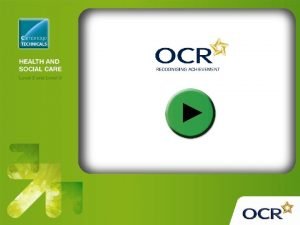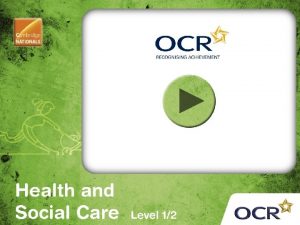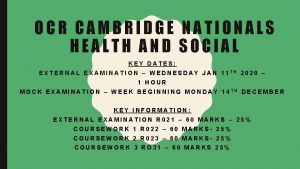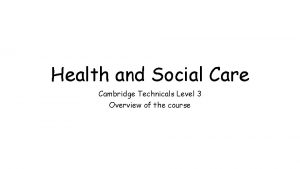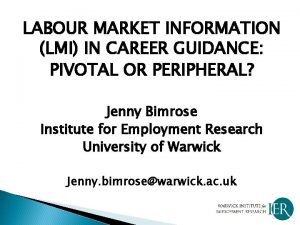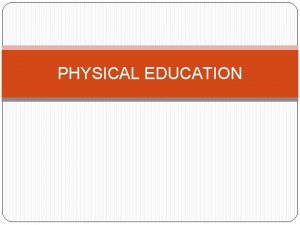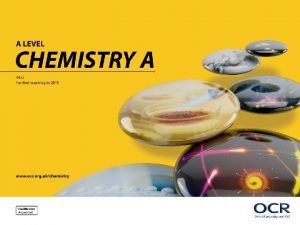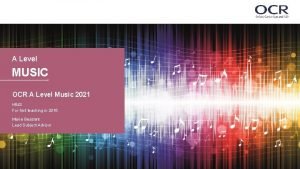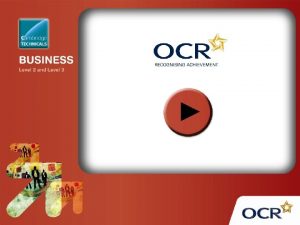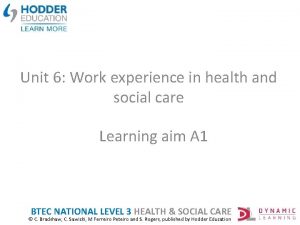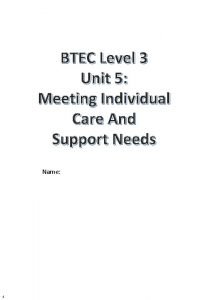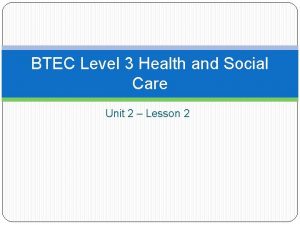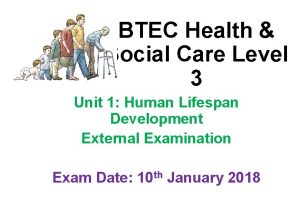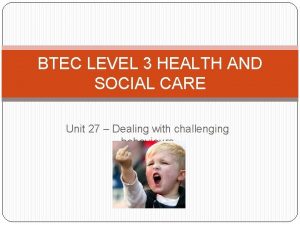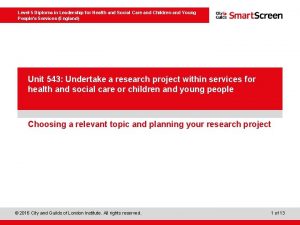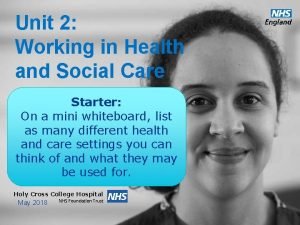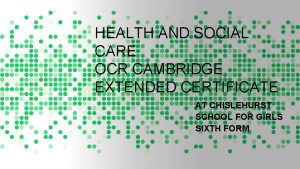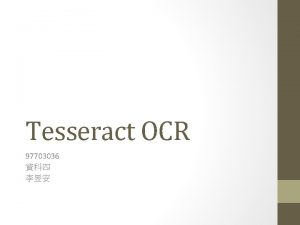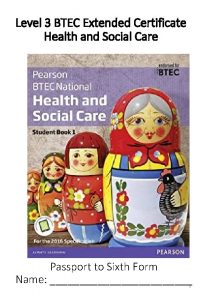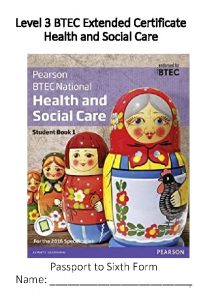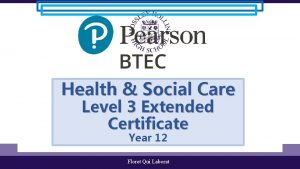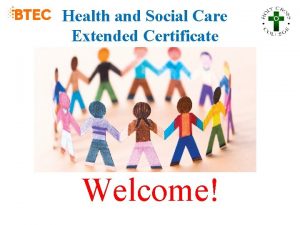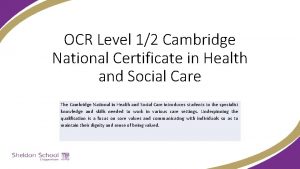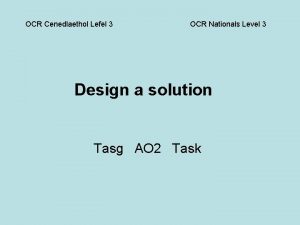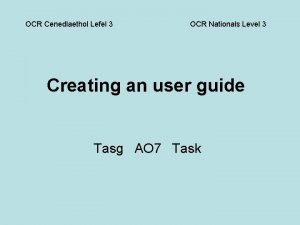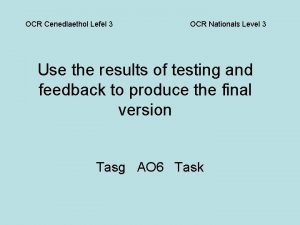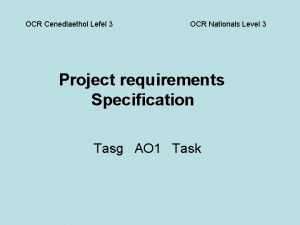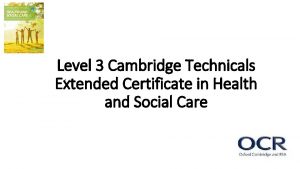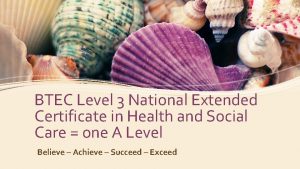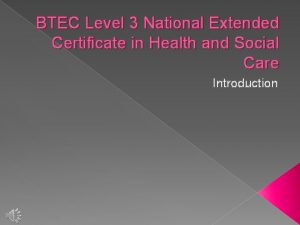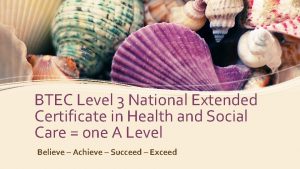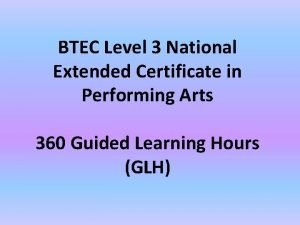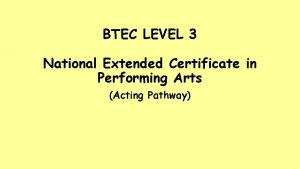Level 3 OCR Extended Certificate Health and Social























- Slides: 23

Level 3 OCR Extended Certificate Health and Social Care Passport to Sixth Form Name: ____________ 1

Contents What will I be studying? Page 3 -4 Recommended Netflix Programmes Page 5 Other recommended watching Page 6 Recommended Reading Page 7 Representations Task Page 8 Learning Log Page 9 Key word Glossary Page 10 -12 A-Z Challenge Page 13 History of the NHS Page 14 Roles in Health and Social Care Page 15 Frontline roles in a pandemic Page 16 True or False Page 17 Extension Task – COVID-19 & Public Health Page 18 -22 Checklist for September Page 23 2

What will I be studying? This course allows you an insight in the many roles available within health and social care from nurses to social workers to child care assistants and beyond they have many key features that we shall explore and apply. You will be studying a range of units which will help you to gain skills that will be valuable in your chosen profession or future study. You will learn about the human body and mind alongside the changes across time. You will learn what it means to work in the sector and what skills and behaviours you will need to develop. We will study the following units; although the final two, in year 13, are subject to change and you may not study them in this order. Unit 1 - Building Positive Relationships in HSC - you will focus on: LO 1 - Understanding relationships in health, social care or child care environments LO 2 - Understanding the factors that influence the building of relationships LO 3 - Understanding how a person-centred approach builds positive relationships in health, social care or child care environments LO 4 - Being able to use communication skills effectively to build positive relationships in a health, social care of child care environment – this includes a chosen role play scenario showing your reflective practice from other Los. • How will you be assessed? You will be assessed through a series of assignments and tasks set that will be marked internally and then externally moderated. You will need to check that your work first meets all the pass criteria before moving on to merit and then finally distinction criteria. This unit will run alongside the other 2 exam units in year 12. Unit 2 - Equality, diversity and rights in health and social care - you will focus on: LO 1 - Concepts of equality, diversity and rights and how these area applied in the context of health, social care and child care environments LO 2 - The impact of discriminatory practice in health, social care and child care environments LO 3 - How current legislation and national initiatives promote anti-discriminatory practice in health, social care and child care environments LO 4 - How equality, diversity and rights are promoted in health, social care and child care environments • How will you be assessed? You will sit an exam (1 ½ hours) which is externally marked. You will practise exam questions before the actual exam to ensure key command verbs are understood. Unit 3 – Health, safety and security in health and social care - you will focus on: LO 1 - Potential hazards in health, social care and child care environments. LO 2 - How legislation, policies and procedures promote health, social care and child care environments. LO 3 - Roles and responsibilities involved in health, safety and security in health, social care and child care environments LO 4 - Responding to incidents and emergencies in a health, social care or child care environment. • How will you be assessed? You will sit an exam (1 ½ hours) which is externally marked. You will practise exam questions before the actual exam to ensure key command verbs are understood. Unit 4 – Anatomy and physiology for health and social care – you will focus on: This unit will be started towards the end of year 12 and completed in year 13. It will run alongside the other two units you will study in year 13. 3

What will I be studying? Unit 4 – Anatomy and physiology for health and social care – you will focus on: LO 1 – The cardiovascular system, malfunctions and their impact upon individuals. LO 2 – The respiratory system, malfunctions and their impact upon individuals. LO 3 – The digestive system, malfunctions and their impact upon individuals. LO 4 – The musculoskeletal system, malfunctions and their impact on individuals. LO 5 – The control and regulatory systems, malfunctions and their impact on individuals. LO 6 – The sensory systems, malfunctions and their impact on individuals. This unit will be started towards the end of year 12 and completed in year 13. It will run alongside the other two units you will study in year 13. • • How will you be assessed? You will sit an exam (2 hours) which is externally marked. You will practise exam questions before the actual exam to ensure key command verbs are understood. This unit will run alongside the other 2 units in year 13. Unit 14 – The impact of long-term physiological conditions - you will focus on: LO 1 - Knowing what long-term physiological conditions are; their causes and symptoms. LO 2 – Understanding the effects of long-term physiological conditions. LO 3 – How to support individuals with long-term physiological conditions to plan their care and support. LO 4 – Knowing about end of life care. • How will you be assessed? You will be assessed through a series of assignments and tasks set that will be marked internally and then externally moderated. You will need to check that your work first meets all the pass criteria before moving on to merit and then finally distinction criteria. This unit will run alongside the exam units in year 13. This unit will support and compliment parts of Unit 4; it is why they will be completed alongside each other. Unit 13 – Sexual health, reproduction and early development stages - you will focus on: LO 1 – Understanding sexual health and contraception. LO 2 – The importance of prenatal health and the process of conception. LO 3 – The factors that could affect heath in pregnancy and birth and the success of the birth. LO 4 – The stages of pregnancy and birth and the postnatal care of the mother. LO 5 – The care and development of the baby in the first year of life. • How will you be assessed? You will be assessed through a series of assignments and tasks set that will be marked internally and then externally moderated. You will need to check that your work first meets all the pass criteria before moving on to merit and then finally distinction criteria. 4

Babies Brain on Fire Girl, interrupted Marriage Story Theory of Everything Call the Midwife Louis Theroux: Extreme love, Dementia What to expect when you’re expecting 13 Reasons Why Five Feet Apart Unbroken Pandemic: How to prevent an outbreak Recommended Watching for Health and 5

Beyond Elizabeth is Missing Jesy Nelson: Odd one out Born to be different Secret life of… Year Olds Bohemian Rhapsody DVD BBC i. Player Rio & Kate: Becoming a Step family Confessions of a Junior Doctor 4 On Demand DVD Still Alice The Children Act The Upside Beautiful Boy Miss you Already Amazon Prime 6

Beyond Wonder by R. J. Palacio The Hate U Give by Angie Thomas Me Before you by Jojo Moyes The Fault in Our Stars by John Green The Language of Kindness by Christie Watson I am Malala by Malala Yousafzai Further Reading Pig Heart Boy by Malorie Blackman Savage Girls and Wild Boys by Michael Newton This is Going to Hurt by Adam Kay When Breathe becomes Air by Paul Kalanithi The Story of Baby P by Ray James The Boy Who Couldn’t Stop Washing by Dr Judith Rapaport Recommended Reading for Health and 7

Health and Social Care in the Media It is important to make the public realise about the issues which are prevailing in society relating to health and social care. One way in which public awareness is raised about health and social care in general and issues that exist within the health and social care sector is through the media. Your task is to pick… ➢ x 2 Films ➢ x 1 Book ➢ x 2 Documentaries You will then be asked to write an essay with the following title: ‘Discuss the portrayal of Health and Social Care within the media’ You must watch/read the some of the examples on the previous slides you have picked and create notes to help with your essay. Consider the following: • What issues, if any, are being raised in the stimulus? • How does the stimulus present H&SC? • Is the stimulus informative/helpful and why? • Are there any quotes/scenes etc that stand out to you and why? • How effective is the stimulus in raising public awareness about H&SC / Issues? This list is NOT exhaustive there may be other questions/ideas you wish to consider as you watch or read. We may get a chance to watch some as a class too. Documentary Suggestions: 8

Learning Log Record here any additional reading/viewing you are undertaking in order to show what you have been completing in order to prepare you for the course. Use the reading list on the previous slides you have been given for guidance on what you could you watch/read. Date Title Summary of content My thoughts 9

Task: Research and define the following key terms which are central to the Units studied during Yr 12. Then, try to draw a symbol to summarise the term and help you remember it. Term Definition Advocate An individual who is able to speak on behalf of another individual; to represent their views, needs and interests when they are unable to do so themselves. Symbol Abuse Allied Health Professionals Alzheimer's Barred list Clostridium difficile Dementia Discrimination Diversity Equality 10

Term Definition Symbol Hazard Health and Safety Executive Hypertension Induction training Kosher Legionella bacteria Legislation LGBTQ+ Mandatory Manual handling 11

Term Definition Symbol Methicillin-resistant (Staphylococcus aureus) Parkinson’s Policies Psychiatrists Psychologists Regulator (re HSC settings) Rights Risk assessment Shabbat Values of care 12

Research a list of Health and Social Care jobs/ medical terms for each letter of the alphabet A B C D E F G H I J K L M N O P Q R S T U V W X Y Z 13

History of the NHS Make a leaflet outlining the history of the NHS Include sections on: • Healthcare before the NHS • When/ why the NHS was produced • What the NHS does • Significance of the NHS • How is the NHS different in other countries The Beveridge Report, 1942 In 1942, a plan had been presented by William Beveridge, a senior civil servant, detailing key areas for post-war reconstruction, aimed at establishing a national system of welfare for the people. It identified ‘five giants’ that were to be overcome: want, disease, ignorance, squalor and idleness. When the Beveridge Report first appeared, it was welcomed by all the parties. There was broad agreement that protection needed to be provided for all members of society, and so when Labour came to power in 1945, they implemented the proposals in this report, thereby establishing the welfare state, a system which all governments after 1951 accepted in its essentials. This common acceptance became known as consensus. Giant The 1945 Labour Government’s Solution Want To be ended by National Insurance. The National Insurance Act created a system whereby the government, employers and employees all paid for insurance which would pay out in the event of unemployment, sickness, maternity and retirement. Disease To be ended by a comprehensive health service. The National Heath Service Act provided free medical and hospital treatment for all (the NHS). Ignorance To be ended by an effective education system. The Labour Party continued to support the Conservative’s 1944 Butler Education Act which provided free education within grammar schools, technical schools or secondary schools. Squalor To be ended by slum clearance and rehousing Idleness To be ended by full employment The idealism that inspired the government’s welfare programme came at a heavy financial cost, which added to the financial burdens it inherited in 1945. 14

Research task Chose a professional from the following: • Midwife • Paramedic • Paediatric nurse • Nutritionist • Physiotherapist You could choose your own idea from health and social care roles if you prefer. Create a fact file for your chosen job role You could include: • A day in the life of…… • General roles and responsibilities • Routes into the role/ qualifications required • Skills & qualities • Average pay • Where they work • Who they work with … and anything else you think may be suitable. 15

On ‘The front line’……. • What does it mean when people talk about being ‘on the front line’? Government declares a ‘pandemic’……. • Job Role What does it mean when people talk about the situation as a pandemic? Definition Roles and Responsibilities How do they respond in a pandemic? District Nurse Auxiliary Nurse Palliative Care Phlebotomist Domiciliary Carer Adult Social Worker 16

True or False? Colour code the statements in order to show if they are true or false. True False A district nurse will only work with the elderly. Adult social workers support people with poor mental health. Only phlebotomists are allowed to take blood. A palliative care nurse will get involved with everyone who gets coronavirus. Domiciliary carers provide care in the home. Auxiliary nurses help support other nurses to do their roles. 17

Optional Extension Task: Health and Social Care in a Pandemic. At the moment, we are living through a time when health and social care services are needed more than ever! Those who have chosen this as a profession have stepped up to look after those affected by the COVID-19 pandemic. You will be seeing on the news constant stories about the amazing work that is going on in the British NHS and Care system and this task is your opportunity to find out more about pandemic control in the area and also the work of the World Health Organisation (WHO) in organising a global response. This will require you to research and understand why the steps have been taken around us and how this fits into the global picture. As this is an extension task you can complete as much of this as you like or are able to but this level of thinking and also detail will help build the skill required for distinction* in your level 3 course. Task 1 – What is the role of health promoters? You will need to read through the following information and complete some research in order to explain the roles of the following organisations in maintaining the health of the population: World Health Organisation (WHO). Department of Health Public Health Agency Clinical Commissioning Groups (CCGs) Health professionals Find out about the organisation of public health promotion within MK. 18

The role of Health Promoters Aims Health promoters aim to improve the health of individuals and the population and reduce health inequalities globally, nationally and locally. Global health promotion The World Health Organization, within the United Nations promotes and protects good health worldwide, by providing information about disease outbreaks, co-ordinating crisis intervention and the response to humanitarian emergencies; establishing International Health Regulations and an international system of classifying diseases. National, regional and local health structures in England include the • Department of Health • Public Health Agency • Clinical Commissioning Groups (CCGs) • Health professionals In England, the Department of Health (DH) leads, shapes and funds health and care while Public Health England protects and improves the nation’s health and well-being, and reduces health inequalities. Local authorities are responsible for public health and do this through health and well-being boards which include representatives for all CCGs in the area, among others. Health and well-being boards assess the needs of their local community through Joint Strategic Needs Assessments (JSNAs) then agree priorities in Joint Health and Well. Being Strategies (JHWSs). Together JSNAs and JHWSs form the basis of commissioning plans for public health for CCGs. Task 2: Why do you think is necessary for local authorities to have control over the needs of the people in their area? For instance, think about the people living in Saltash and then compare that to the population living in Milton Keynes; do they have the same needs? What would their focus for health be on? Have a look at Cornwall CCG. How many GP practices does East Cornwall have? Clinical Commissioning Group 19

Approaches to promoting public health and well-being Promoting public health and well-being includes: 1. Monitoring the health status of the community and identifying those most at risk, e. g. children, unemployed, older people, minority ethnic groups. 2. Health surveillance programmes. 3. Targeted education and health awareness and health promotion programmes. 4. Socio-economic support to reduce health inequality between individuals and communities, e. g. winter fuel payments, free school meals, housing support. 5. Improving access to health and care services. 6. Co-ordinating national and local services. 7. Disease registration to inform of health trends and for strategic health planning. 8. Statutory duty to notify certain communicable diseases e. g. measles, tuberculosis and recently case COVID-19. Task 3 – Find examples of the British Government and relevant agencies putting these measures into practice; e. g. what have they done for those receiving free school meals? How have they identified those most at risk and supported them? Task 4: Compare Britain’s response to at least one other country and its response to the pandemic. Assess the strengths and weaknesses in each approach to looking after public health. Challenge: Look at least 3 news articles from a variety of sources and consider what they say about the British approach to the pandemic. Do you think it could have been improved? Justify your suggestions. 20

Pandemic Phases 2018 marks the 100 th anniversary of one of the largest public health crises in modern history, the 1918 influenza pandemic known colloquially as “Spanish flu. ” The intensity and speed with which it struck were almost unimaginable – infecting onethird of the Earth’s population, which at the time was about 500 million people. By the time it subsided in 1920, tens of millions people are thought to have died. By 1952, it was decided that an influenza surveillance system was needed for the “collection, correlation, and distribution of information regarding occurrence, epidemiology and laboratory findings”. This is known as the Global Influenza Surveillance and Response System (GISRS). It was predicted that the next pandemic would most likely be caused by influenza. This has lead WHO to conduct and watch outbreaks of strains of flu and cold across the world and create detailed reports on the readiness of countries and also to map out the stages of a pandemic and main actions to be taken in order to minimise the impact of this type of event. Task 5: Below is a link to the WHO pandemic phase descriptions; use these alongside research on the response to the COVID-19 Pandemic in order to complete the table on the next slide. https: //www. who. int/influenza/resources/documents/pandemi c_phase_descriptions_and_actions. pdf 21

Phase WHO Suggested Actions UK Actions Effectiveness of response Recommendations for future pandemic planning 1 2 3 4 5 6 Post Peak 22

Passport to Sixth Form Check list Use this list to make sure you have everything you need to hand in in September in order to start your OCR Level 3 in Health and Social Care. Essay about representations in the media, page 8. Complete at least 6 sections of the learning log, page 9. Completed glossary of key terms, page 10 -12. Filled in A-Z of Health and Social Care, page 13. Leaflet on the history of the NHS, page 14. One in depth fact file on a role within the Health and Social Care sector, page 15. Completed front line roles table, page 16. Highlighted true or false sheet, page 17. Optional, Extension task – Current events – Health and Social Care in a pandemic, page 18
 Ocr health and social care level 3
Ocr health and social care level 3 Ocr health and social care level 3
Ocr health and social care level 3 Ocr health and social care
Ocr health and social care Ocr key dates
Ocr key dates Cambridge technicals level 3 health and social care unit 2
Cambridge technicals level 3 health and social care unit 2 Ocr level 3 sport and physical activity
Ocr level 3 sport and physical activity Ocr level 6 diploma in career guidance and development
Ocr level 6 diploma in career guidance and development Health and social care component 3
Health and social care component 3 Cambridge technicals level 3 business
Cambridge technicals level 3 business Ocr cambridge technicals level 3 sport unit 1
Ocr cambridge technicals level 3 sport unit 1 Ocr gcse computer science algorithm questions
Ocr gcse computer science algorithm questions Ocr
Ocr A level chemistry ocr organic synthesis
A level chemistry ocr organic synthesis Ocr
Ocr Ocr business level 3
Ocr business level 3 Btec health and social care level 3 unit 6: work experience
Btec health and social care level 3 unit 6: work experience Physiological disorders health and social care
Physiological disorders health and social care Pearson health and social care
Pearson health and social care Unit 5 learning aim d
Unit 5 learning aim d Btec level 3 health and social care unit 2
Btec level 3 health and social care unit 2 Unit 12 health and social care level 3
Unit 12 health and social care level 3 Btec level 3 health and social care unit 4
Btec level 3 health and social care unit 4 Level 5 health and social care research project examples
Level 5 health and social care research project examples Unit 2 health and social care level 3 past papers
Unit 2 health and social care level 3 past papers
